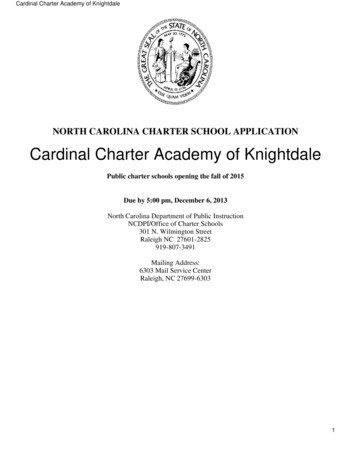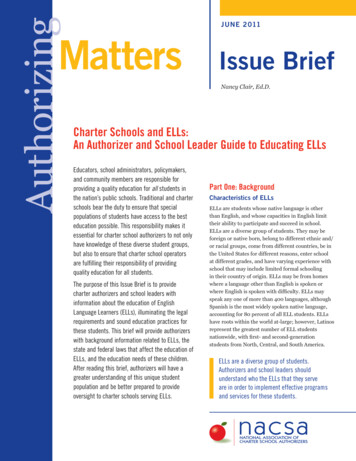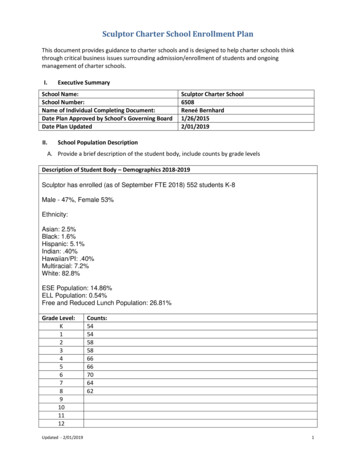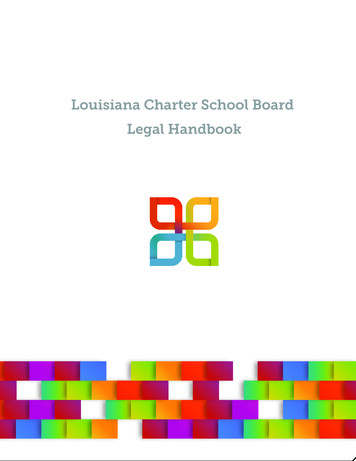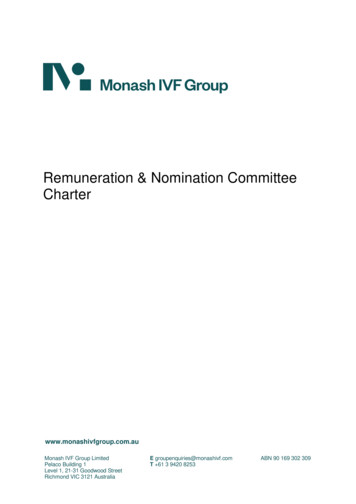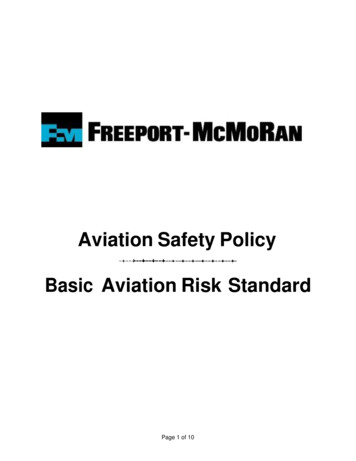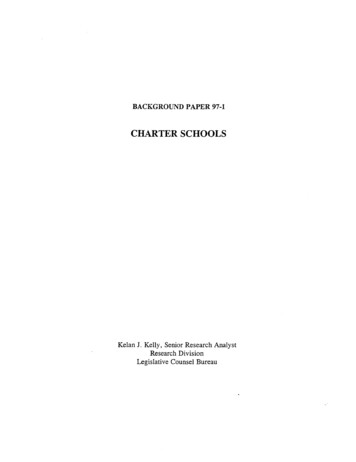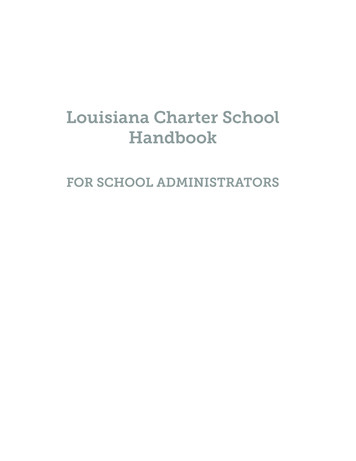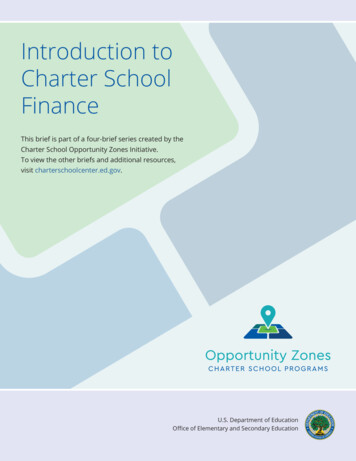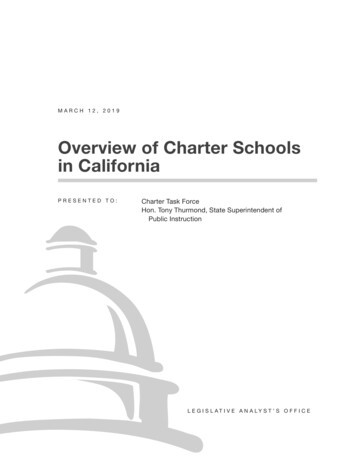
Transcription
MARCH 12, 2019Overview of Charter Schoolsin CaliforniaPRESENTED TO:Charter Task ForceHon. Tony Thurmond, State Superintendent ofPublic InstructionL E G I S L AT I V E A N A LY S T ’ S O F F I C E
Origin of Charter Schools in CaliforniaCalifornia Established Charter Schools in 1992 The state created charter schools to offer parents an alternative totraditional public schools and encourage local leaders to exploreinnovative educational programs.Charter Schools Must Meet Three Basic State Requirements All charter schools must: (1) provide nonsectarian instruction,(2) charge no tuition, and (3) admit all interested California studentsup to school capacity.Charter Schools Are Held Accountable to Local Charter To both open and be renewed, a charter school in California musthave an approved charter that sets forth a comprehensive vision forthe school. Charter schools are exempt from many state laws and regulationsthat apply to traditional public schools.L E G I S L A T I V E A N A LY S T ’ S O F F I C E1
Graphic Sign OffSecretaryAnalystMPADeputyHandout Template.ait ARTWORK #190187Charter SchoolEnrollment in CaliforniaCharter School EnrollmentHas Been on Steady Climb UpwardCharter Schools as Share of Overall able Growth in Enrollment In 2017-18, California had 1,254 charter schools serving about630,000 students (10.2 percent of public school students). Ten yearsearlier, the state had 682 charter schools serving about 260,000students (4.2 percent).L E G I S L A T I V E A N A LY S T ’ S O F F I C E2
Characteristics of Charter Schools in CaliforniaCharter Schools Tend to Be Small The median charter school enrolls about 250 students whereas themedian noncharter public school enrolls about 525 students.Charter Schools Are Concentrated in Some Urban Areas The Bay Area, Los Angeles County, and San Diego County accountfor more than 60 percent of all charter schools in the state.Most Charter Schools Are Start-Ups About 85 percent of charter schools are newly created start-upwhereas 15 percent are conversions of existing public schools.Most Charter Schools Are Classroom Based About 80 of charter schools offer traditional classroom-basedinstruction whereas the remainder offer some form of independentstudy.L E G I S L A T I V E A N A LY S T ’ S O F F I C E3
Graphic Sign OffSecretaryAnalystMPADeputyCharacteristics ofHandout Template.aitARTWORK#190187Charter SchoolStudents inCaliforniaOn Average, Charter Schools ServeStudents Similar to Other Public SchoolsShare of Overall Enrollment, 2017-1859%Low Income60%16%English Learners24%Students 3%8%5%L E G I S L A T I V E A N A LY S T ’ S O F F I C ECharter SchoolsTraditional Public Schools4
Charter School Petitions and Authorizers inCaliforniaInterested Groups Initiate Petition Process Petitions must set forth a comprehensive vision for the school,including: its educational program, student discipline policy,employee policies, governance structure, and fiscal plans. Petitions must be signed by a certain share of interested teachers orparents.California Has Three Allowable Types of Charter Authorizers In most cases, an interested group submits its petition to the schooldistrict where the charter school will be located. Districts authorize86 percent of active charter schools. Under certain conditions, a group may submit a petition to the countyoffice of education (COE) or directly to the State Board of Education(SBE). COEs authorize 12 percent of active charter schools and SBEauthorizes 2 percent. Initial authorization is for a period of up to five years.Variation Exists in Charter Schools Per Authorizer More than half of authorizers in California oversee one charter school. Los Angeles Unified and San Diego Unified oversee more thanone-quarter of all charter schools in the state.Under Certain Conditions, an Authorizer Can Reject a Petition An authorizer may deny a petition for five reasons: (1) insufficientsignatures, (2) the proposed school violates one of the three basicstate requirements, (3) the petition does not include a reasonablycomprehensive vision for the school, (4) the proposed educationalprogram is unsound, or (5) petitioners are unlikely to successfullyimplement their program.L E G I S L A T I V E A N A LY S T ’ S O F F I C E5
Ongoing Oversight of Charter SchoolsAuthorizers Are Responsible for Ongoing Oversight At a minimum, each authorizer must fulfill five basic responsibilities:(1) identify a contact person at the charter school; (2) visit the charterschool at least annually; (3) ensure the charter school completes allrequired reports, including the Local Control and Accountability Plan;(4) monitor the charter school’s finances; and (5) notify the SBE if acharter is renewed, revoked, or the school closes. Authorizers typically charge a fee of up to 1 percent of charter schoolrevenue to cover the cost of their oversight activities.Charter Schools Must Be Renewed At the end of a charter’s initial authorization period, the authorizermust decide whether to renew the charter. Charters typically must berenewed every five years. The criteria for the renewal progress generally is similar to that forapproving a new charter, with the exception that charter schoolsseeking renewal must demonstrate a minimum level of academicperformance. These minimum performance standards have not been updated toreflect changes to the state’s assessment and accountability system.L E G I S L A T I V E A N A LY S T ’ S O F F I C E6
Charter School FundingAs With Districts, Charter Schools Are Mostly Supported by theLocal Control Funding Formula (LCFF) Base funding is generated by all students, with rates varying bygrade span. Supplemental funding is generated by English learner andlow-income (EL/LI) students. Concentration funding is generated by districts/charter schoolsserving large shares of EL/LI students. Unlike for districts, concentration funding is capped for charterschools. It is capped at the lower of: the share of EL/LI students thecharter school serves or the share its authorizing district serves. (Weestimate the cap reduced charter school funding by 82 million in2018-19.)Charter Schools Received 6.6 Billion From LCFF in 2018-19 Charter schools receive 10.5 percent of total LCFF funding.Charter Schools Also Tend to Receive Some CategoricalFunding Major categorical programs include special education, after schoolprograms, school meals programs, and the mandates block grant. For the mandates block grant, charter schools receive roughly halfthe per-student funding rate as school districts. Historically, charter schools have tended to have lower participationin categorical programs than school districts.L E G I S L A T I V E A N A LY S T ’ S O F F I C E7
Charter School FacilitiesCharter Schools Have Three Options for Obtaining Facilities About half of charter schools occupy facilities provided by theirauthorizing district, typically paying either nominal or below-marketrent. Most remaining charter schools occupy privately leased facilities,often paying market-rate rent. A relatively small share of charter schools have constructed their ownfacilities.Charter Schools Often Cover Facility Costs From OperatingBudgets Charter schools are unable to authorize local bonds for schoolfacilities. The state and federal governments provide some funding to helpcharter schools with their facility costs. The California School FinanceAuthority administers these programs.L E G I S L A T I V E A N A LY S T ’ S O F F I C E8
Charter School Facilities(Continued)Key Charter School Facility DevelopmentsYearDevelopment1992The state enacts the California Charter Schools Act, which authorizes charter schools but makes nospecific provision for their facilities. Initially, many charter schools are conversions of district schoolsand remain in their existing facilities.1998An increasing share of charter schools are start-ups rather than conversions of existing schools.Chapter 34 (AB 544, Alpert) gives charter schools the right to occupy unused district facilities at nocharge, provided the charter schools agree to maintain the facilities.2000Voters approve Proposition 39, which requires school districts to provide charter schools with facilitiesthat are “reasonably equivalent” to those occupied by district students. Charter schools in thesefacilities must pay a pro-rata share of their districts’ annual facility costs. The measure also lowersthe vote threshold for districts to pass local facility bonds.2001Chapter 892 (SB 740, O’Connell) establishes the Charter School Facility Grant Program for charterschools that enroll or are located in the attendance area of an elementary school where at least70 percent of students are low income. Eligible schools are reimbursed for up to 75 percent oflease and other qualifying facility expenditures incurred in the prior year but are capped at 750per student. As part of an agreement to offset the cost of the program, the legislation also reducesgeneral purpose funding for certain nonclassroom-based charter schools.2002Chapter 935 (AB 15, Goldberg) creates the Charter School Facilities Program, which provides statefunding for charter schools to build their own facilities. (Voters approve funding for the programthrough statewide bond measures on the 2002, 2004, 2006, and 2016 ballots.)2005The California School Finance Authority begins making grants under the Charter School FacilitiesIncentive Grant program. This federally funded program provides qualifying charter schools withfunding for leases, construction, renovation, and other facility costs.2012Chapter 38 (SB 1016, Committee on the Budget) requires school districts selling or leasing surplusproperty to offer that property to interested charter schools before any other party and caps the saleor lease price through a formula. These provisions sunset on July 1, 2016.20132018Trailer bills make various changes to the Charter School Facility Grant program: shifting administrationfrom the California Department of Education to the California School Finance Authority, reducing thethreshold for qualifying schools from 70 percent to 55 percent low-income students, increasing themaximum per-student grant amount, and capping growth in applicable lease costs.L E G I S L A T I V E A N A LY S T ’ S O F F I C E9
Charter School LegislationMajor Statutory Changes to Charter School OperationsLegislationYearChapterBill199834(AB 544, Lempert)Clarified criteria for approving or denying charterpetitions. Allowed charter schools to appeal a rejectedpetition to the COE or SBE. Authorized SBE to grantand revoke charters under specified conditions.1999162(SB 434, Johnston)Required independent study programs run by charterschools to provide a minimum number of instructionalminutes.2000160(SB 326, Lewis)Allowed charter schools to appeal a revoked charter tothe COE or SBE.2001344(SB 675, Poochigan)Required charter schools to submit annual financialand compliance reports to CDE in addition to theirauthorizer.2001892(SB 740, O’Connell)Authorized the SBE to reduce funding for nonclassroombased charter schools that spend too little oninstruction.20021058(AB 1994, Reyes)Increased financial reporting requirements for charterschools. Limited ability of charter schools to locateanywhere in the state.2003892(AB 1137, Reyes)Required charter schools seeking renewal to meetschoolwide minimum academic performancestandards.2012576(AB 1290, Alquist)Required charter schools seeking renewal to meetminimum academic performance standards for studentsubgroups.201349(SB 91, Committee onBudget and FiscalReview)Required charter schools to develop Local Controland Accountability Plans similar to those required ofdistricts and COEs.2018291(AB 406, McCarty)Prohibited for-profit organizations from operating charterschools.20193(SB 126, Leyva)Explicitly subjected charter schools to open meetings,public record, and conflicts-of-interest requirementspreviously applied to districts and other localgovernments.ChangeCOE county office of education; SBE State Board of Education; and CDE California Department of Education.L E G I S L A T I V E A N A LY S T ’ S O F F I C E10
Charter School Policy IssuesSeveral Issues for the State to Consider Have charter schools generated overall improvement in California’spublic school system? Is California’s district-centered system for providing charter schoolauthorization and oversight the most cost-effective approach? Is the way California supports charter schools in finding and fundingtheir facilities cost-effective? Are special education costs distributed equitably among charterschools and school districts? How could performance expectations for charter renewal be alignedwith the state’s new assessment and accountability system?L E G I S L A T I V E A N A LY S T ’ S O F F I C E11
The median charter school enrolls about 250 students whereas the median noncharter public school enrolls about 525 students. Charter Schools Are Concentrated in Some Urban Areas The Bay Area, Los Angeles County, and San Diego County account for more than 60 percent of all charter schools in the state. Most Charter Schools Are Start-Ups
